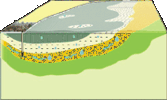| Studia Geologica Polonica |  |
Hydrogeology and Hydrogeochemistry
Edited by J. Dowgia³³o
Part I
Origin of mineralized waters in the Central Carpathian Synclinorium, SE Poland
Porowski, A.
Studia Geologica Polonica, 125: 5-66. PDF - Full-text Article
Abstract
Adam Porowski
Polish Academy of Sciences, Institute of Geological Sciences, ul. Twarda 51/55, 00-818 Warszawa, Poland; adamp@twarda.pan.pl
The Central Carpathian Synclinorium (CCS) is a large tectonic structure within the easternmost part of the Silesian Nappe of the Polish Outer Carpathians. This area, built of flysch sediments of the Upper Cretaceous to Oligocene ages, abounds with mineralized waters associated to a varying extent with oil and gas deposits. The chemical composition of 81water samples and the isotopic composition (δ18O and δD) of 45 samples were studied in detail in order to shed light on their origin. Additionally, the tritium content was determined in 25 water samples, and δ18O values of authigenic calcite (vein and cement) from core samples of four boreholes were measured. All the waters studied are brackish or saline (TDS up to 48.9 g/dm3) and belong to four hydrochemical classes: Cl-Na, Cl-HCO3-Na, HCO3-Cl-Na, and HCO3-Na. Their isotopic composition locates them to the right of the Global Meteoric Water Line (GMWL). Relative to the Standard Mean Ocean Water (SMOW) they are depleted in D, while some of them are depleted and others enriched in 18O. The origin of these waters is poligenetic. The observed isotopic composition can be explained by mixing of at least three components of different origin: (i) meteoric waters of modern hydrological cycle; (ii) diagenetic waters formed during dehydration of clay minerals (transformation of smectite to illite within mixed-layer smectite/illite), and (iii) connate water - chemically modified seawater trapped in pores of marine sediments before their diagenesis. It is also likely that some waters contain a fraction of paleoinfiltration waters. Chemical composition of the studied waters has been modified mainly due to dilution processes and water-rock interaction. Presumably, their original chemical composition was derived from seawater-like interstitial fluids.
Key words: Central Carpathian Synclinorium, oil-associated water, connate water, metamorphic water, dehydration, dilution, mixing
Polish Academy of Sciences, Institute of Geological Sciences, ul. Twarda 51/55, 00-818 Warszawa, Poland; adamp@twarda.pan.pl
The Central Carpathian Synclinorium (CCS) is a large tectonic structure within the easternmost part of the Silesian Nappe of the Polish Outer Carpathians. This area, built of flysch sediments of the Upper Cretaceous to Oligocene ages, abounds with mineralized waters associated to a varying extent with oil and gas deposits. The chemical composition of 81water samples and the isotopic composition (δ18O and δD) of 45 samples were studied in detail in order to shed light on their origin. Additionally, the tritium content was determined in 25 water samples, and δ18O values of authigenic calcite (vein and cement) from core samples of four boreholes were measured. All the waters studied are brackish or saline (TDS up to 48.9 g/dm3) and belong to four hydrochemical classes: Cl-Na, Cl-HCO3-Na, HCO3-Cl-Na, and HCO3-Na. Their isotopic composition locates them to the right of the Global Meteoric Water Line (GMWL). Relative to the Standard Mean Ocean Water (SMOW) they are depleted in D, while some of them are depleted and others enriched in 18O. The origin of these waters is poligenetic. The observed isotopic composition can be explained by mixing of at least three components of different origin: (i) meteoric waters of modern hydrological cycle; (ii) diagenetic waters formed during dehydration of clay minerals (transformation of smectite to illite within mixed-layer smectite/illite), and (iii) connate water - chemically modified seawater trapped in pores of marine sediments before their diagenesis. It is also likely that some waters contain a fraction of paleoinfiltration waters. Chemical composition of the studied waters has been modified mainly due to dilution processes and water-rock interaction. Presumably, their original chemical composition was derived from seawater-like interstitial fluids.
Key words: Central Carpathian Synclinorium, oil-associated water, connate water, metamorphic water, dehydration, dilution, mixing